Mavic shoes 2013
You probably know Mavic for their wheels. This French manufacturer is indeed one of the largest bicycle wheel producers in the world. They have a rich history in road racing, known for outstanding aluminum braking surfaces, and the then-revolutionary mass production of bladed aluminum spokes on the original Ksyrium line. More recently, Mavic made a push in to triathlon, debuting a line of training and racing tires, along with the unique Cosmic CXR80 wheel set (complete with aerodynamic rubber ‘Blades’ that fill in the gap between rim and tire).
What you may not know is that Mavic makes more than just wheels and tires. Indeed, they have pedals, helmets, cycling computers, apparel, and now – a very complete line of cycling shoes. Herein, we offer an overview of the 2013 Mavic shoe line-up, along with my impressions from road testing several models.
Triathlon shoes
Mavic has two models of triathlon-specific shoe – the top-end Tri Helium, and the lower priced Tri Race. At $350 and $200, respectively, neither could be called cheap, but they compare to pricepoints from other manufacturers. Sidi, for example, sells their top-end T3.6 Vent Carbon triathlon shoe for $360. Now, you can question whether a shoe-newcomer like Mavic ought to be selling shoes for the same price as industry stalwarts like Sidi, but I say – let the proof be in the pudding. If the shoes are good and the glove doesn't fit, you must acquit.
Your color options are as follows: Tri Helium – screaming Mavic yellow only. Tri Race – white only.
The 2013 Mavic Tri Helium:
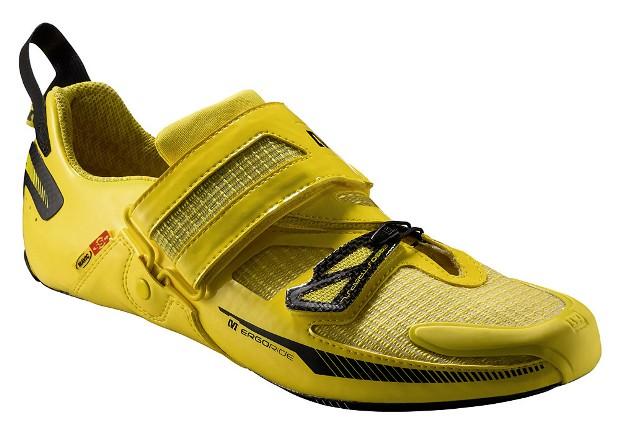
I had the opportunity to test the 2012 version of the Tri Helium for several months, and more recently received a pair of 2013’s to compare them to. Overall, I quite liked them both. My first impression? These are some stiff shoes. Go ahead – push down as hard as you can on those soles… they aren’t going anywhere. One of the updates for 2013 is a new sole design, said to be even more rigid than the 2012 (however, having tried them both, I can’t perceive a difference). The sole also gained large cutouts for venting. The image below details the 2012 (left) and the 2013 (right):
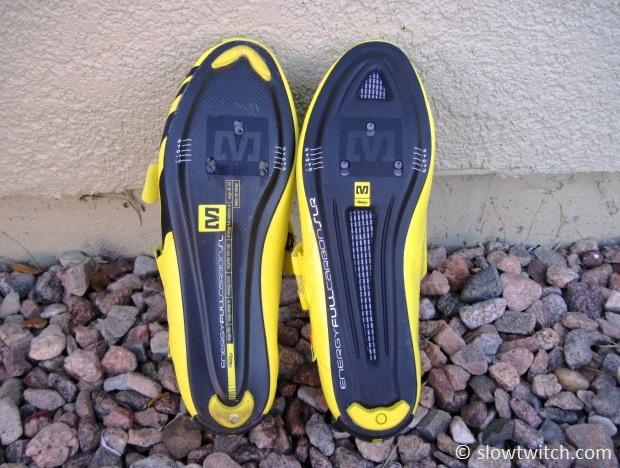
But the shoes are not just stiff for pushing down. No – you can pull up, push forward, pull back… do anything you darn well please. The closure system features one large strap and one small secondary strap. The main strap closure makes this shoe the most secure-feeling tri shoe I’ve used – and strikingly close to a road shoe with ratcheting buckle. My primary shoe before the Tri Heliums was a set of Specialized Trivents. I love my Trivents. However, these Mavics proved to be a different experience entirely. There are no more mid-ride checks to tighten the Velcro back down. The closure system in general feels positively vault-like. For the first ride or two, I was having to re-think my pedal stroke. It’s almost as though the shoe has so little ‘give’ in any direction, that it brings out your own small pedal stroke deficiencies. Most specifically, if you’re not used to dorsi flexing much during the up-stroke, these shoes will slap you on the wrist (or… ankle?) for it.
In order to make the closure system as ankle-friendly as possible, Mavic has done a good job of padding the entire opening. As well, the 2013 model features a new swiveling strap, intended to offer a more comfortable fit for different foot shapes and sizes.
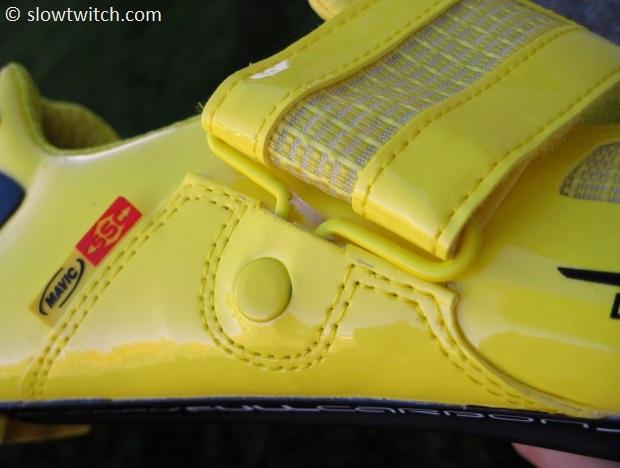
The strap also features cut lines, so you can trim it to length. One criticism Mavic heard loud and clear on the 2012’s was dislike of a no-trim strap that was too long, and could contact the crankarms while pedaling.
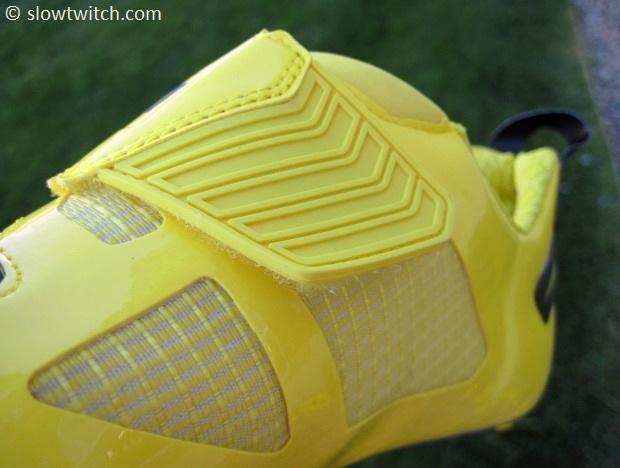
I personally trimmed off two segments for a perfect fit.
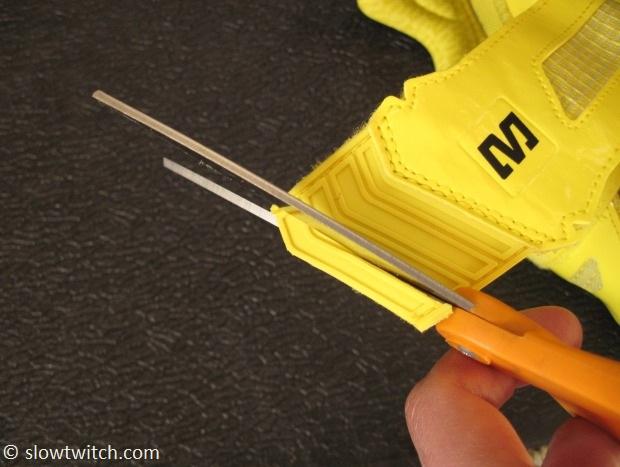
Padding is generous, and works well for sockless wear.
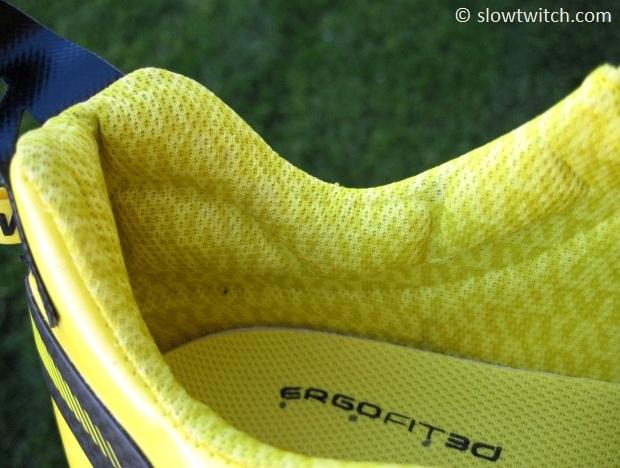
Mavic offers only one width in triathlon shoes. I’d call it ‘medium-wide’. I generally like wider shoes, and these have plenty of room.
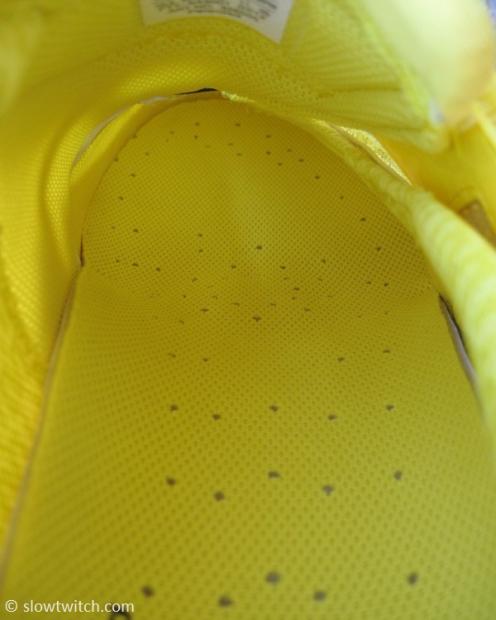
One feature that lends to the overall stiffness of the shoe is a carbon heel counter, dubbed Energy Lock. Before I tried the shoes, I thought this was a gimmicky sales feature that wouldn’t really do anything. How much could a heel really move? Do you really need carbon to hold it together? In fact, from the first time I turned the pedals over with these shoes, the heel counter was the first thing I noticed. Its function becomes very apparent at about 6 or 7 o’clock in the pedal stroke – right as you begin to pull up and back.
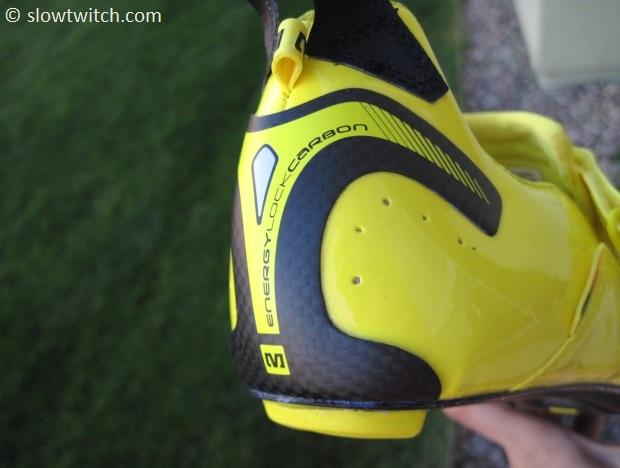
The rear of the shoe also features a generous sized finger loop for quick transitions. Note the small supplemental loop, specifically made for a rubber band (for those who pre-install their shoes on the pedals for a flying-bike-mount).
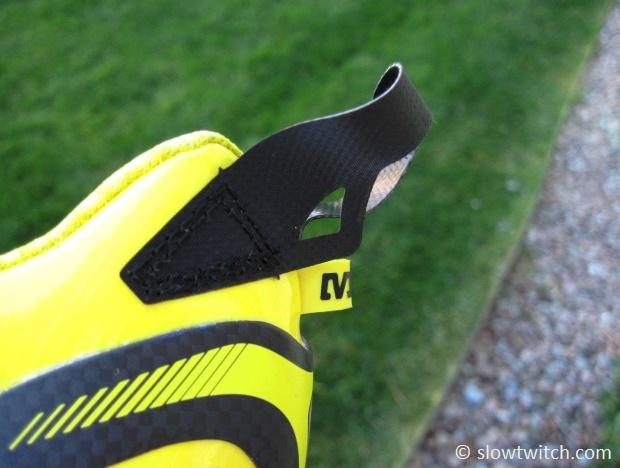
Cleat placement on the Tri Helium is something worth mentioning. All Mavic road shoes seem to have a reputation for a more forward cleat placement than most other brands. In order to get my cleats where I wanted them, they are pushed all the way back. The cleat nuts themselves also have 6mm of fore-aft adjustment themselves, which I pushed rearward. In the end, I was a couple millimeters further forward than on my other shoes, but it wasn’t enough that I noticed a difference. If you prefer a mid-foot cleat placement, these shoes will likely not work for you.
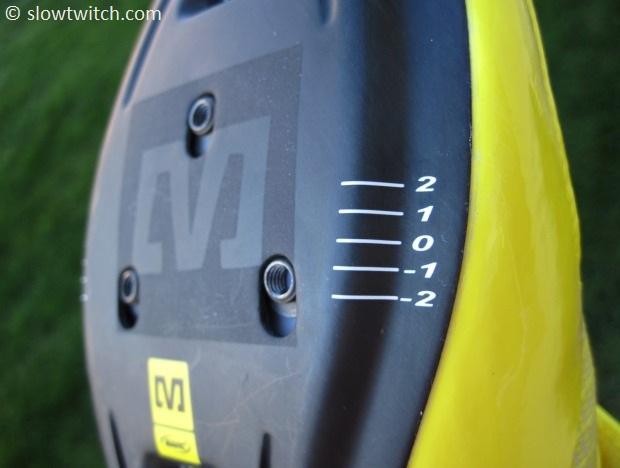
Sizing for Mavic shoes seems to run large. In US running shoes, I’m usually a 12. Very occasionally, I’ll wear an 11.5, depending on brand or style. In various brands of cycling shoes, that usually puts me around EU 45 or 46. I tried on the 11.5 Mavic, and it was immediately clear that it was too large. I’m now in an 11 US (45 1/3 EU), and they fit great. The take home here – as with any cycling shoe – is to try it on in a brick-and-mortar store.
Road shoes
For those shopping for a road-specific shoe, Mavic has a wide range of offerings. Similar to their tri line, there is a top-tier model and a second tier. The road line also adds many lower price points below that.
The top of the heap is the Zxellium Ultimate. At 270 grams and $475, this sucker is technology-packed and priced to match. Below that are the ‘standard’ Zxellium at $300, and the Zxellium Maxi – made for wide feet. The whole Zxellium line has their Ergo Lite ratchet system, offering micro adjustment and a secure feel.
The Zxellium Ultimate breaks Mavic tradition for top-end shoes and is available in a color other than bright yellow (although yellow is still available). Here is the black option:
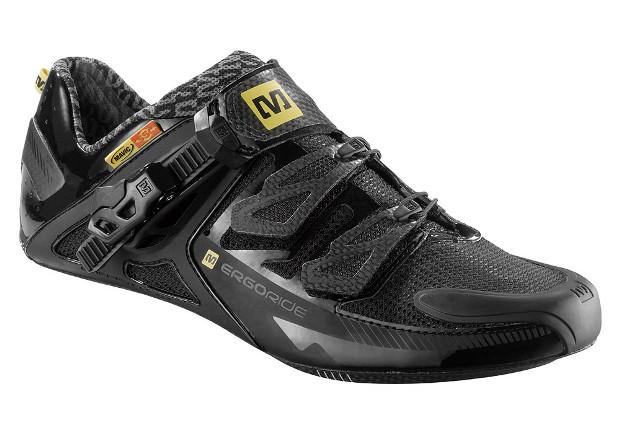
The other offering you may find interesting is their climber’s-special Huez shoe. Take the Zxellium, pare it down to the bare essentials, remove the ratchet in favor of an all-Velcro closure system, and you have a very stiff, very light (200g) shoe.
I did not personally try any of the Mavic road shoes, but their general construction and design intent (i.e. very stiff) looks to be in-line with the triathlon shoes.
Mountain shoes
With winter looming for us in the Northern hemisphere, we wanted to include some information on Mavic’s mountain bike shoe offerings. Many of our readers take to their mountain or cyclocross bikes during this time, for a change of pace and scenery.
Mavic starts with their bright-yellow Fury, at $325. While it appears to be a nice shoe, I was interested in testing a more price-friendly option. Many triathletes seem to follow a pattern of spending top dollar on their tri equipment, but opting for mid-to-low-end equipment for their off-season gear. Below the Fury sits the Chasm, at $240 (pictured below).
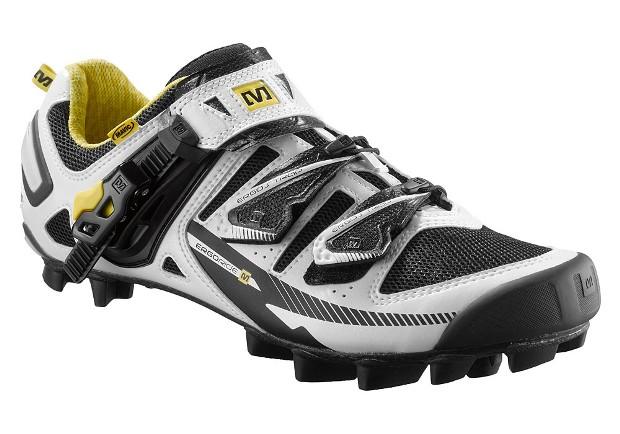
The Chasm is a ‘summer’ shoe; something you’d use for warm weather riding. I found them to exhibit all of the good traits of the triathlon shoes, in a mountain package. Sizing seemed identical, and the ratchet system is simple and functional. Cleat placement does seem more flexible than the road and tri models – I had no trouble putting the cleats exactly where I wanted them, and still had some rearward adjustment to spare.
The sleeper in the Mavic MTB shoe line, however, is the Scree. You see, I really dislike putting toe covers on mountain shoes. They never work well, due to the shoe’s tread. So, I have two options. Option one is to suck it up and ride with cold feet. Option two is to use my dedicated winter cycling shoes, which are ankle-high and have no venting. The only problem with the winter shoes is the fact that they’re a full size larger than my normal MTB shoes. I did this on purpose to accommodate (very) thick wool socks. When it’s REALLY cold out, they work fantastic. In the middle temperatures – say, 25 to 40 degrees Fahrenheit – they are too warm. And if I wear thin socks, the shoes are too big. What to do?!
Enter the Scree. This is a dedicated mid-temperature shoe. It is a mid-ankle height, and the upper is made of wind-blocking Gore-Tex. It’s warm, but not too warm.
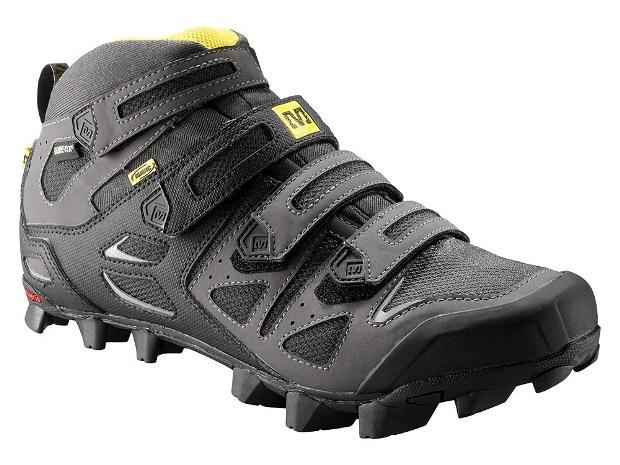
I found them to do everything I’d hoped. I ordered the shoes in my normal size (US 11, for Mavic). I can wear them with thin summer socks, or mid-temperature thin wool socks.
Pictured below: the Chasm (left), and the mid-temperature Scree (right):
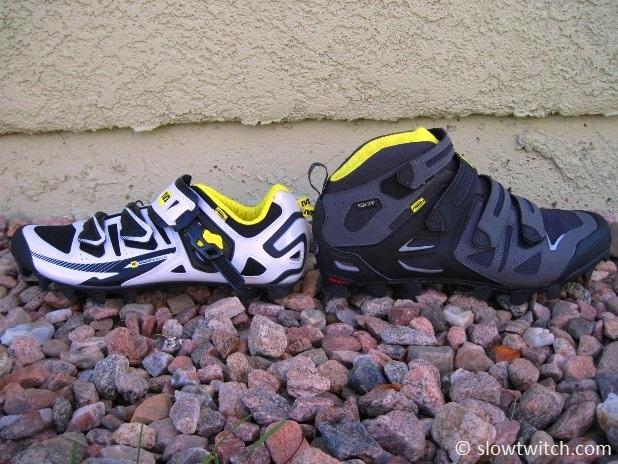
Both models feature generous tread on the bottom. They felt much more stable than the shoes I was coming from; the tread is deep, and the rubber compound feels soft and grippy. Note the slightly more aggressive tread of the Scree (right):
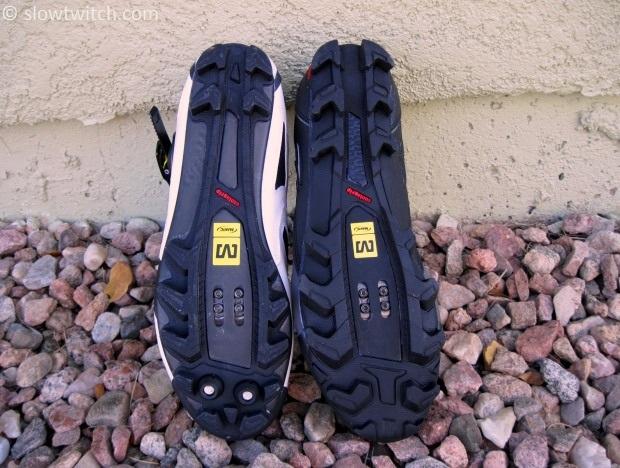
The Scree is a relative steal at $189. Mavic also offers a full-winter MTB shoe, called the Drift, for $199.
If you do much fall or winter riding on a cyclocross or moutain bike, these shoes are a very sound investment (and pale in comparison to the amount that most of us spend in a year on running footwear). I bought my full-on winter shoes about five years ago, and they're one of the best cycling investments I've made. Now that I have the new Scree, I consider my complement of shoes to be complete.
For those who stick to the roads year-round, Mavic does have a winter-specific road shoe, called the Frost. Based on the Drift, it features standard road cleat holes, and no aggressive tread.



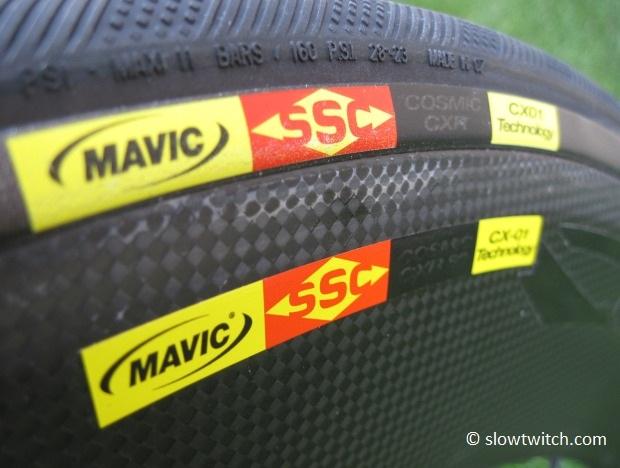
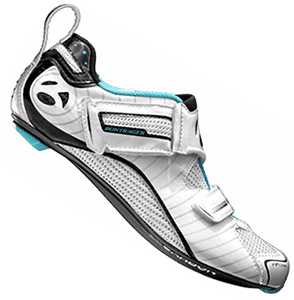
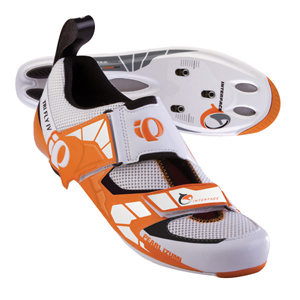
Start the discussion at forum.slowtwitch.com